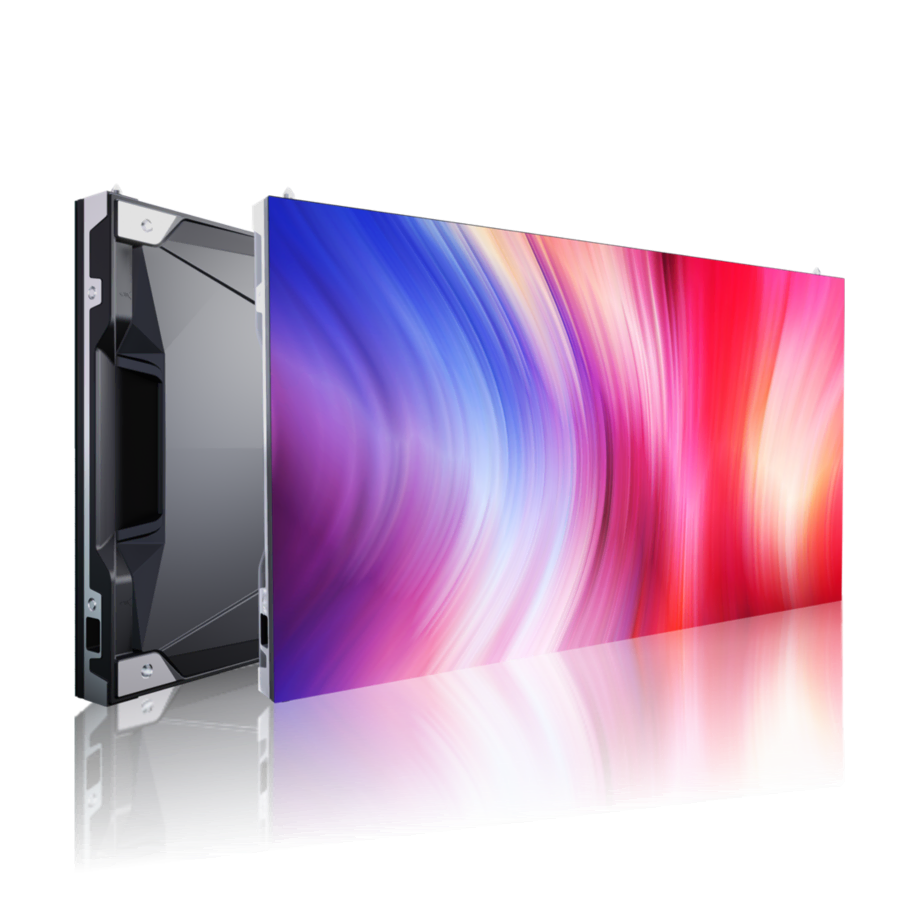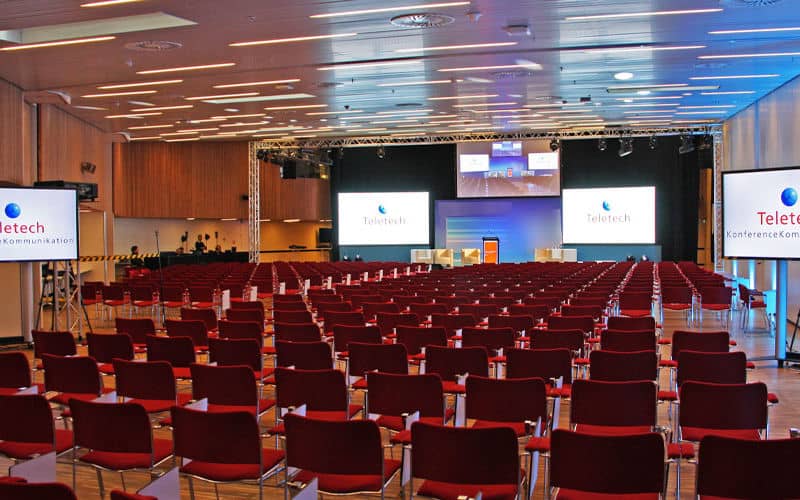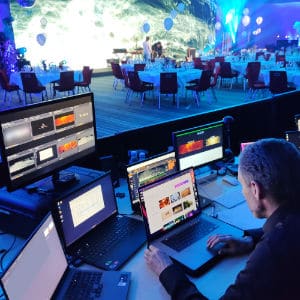Guide & checklist: Visual AV solutions
The right visual AV solution for your event is important in terms of reaching your audience in the right way. Flat screens and large projectors are often used, but for product presentations and the like, large LED walls can also be a great solution with many options. The right stage setup and backdrop are also important.


The different screen types
Flat screens and projectors are used at many events. This applies whether they are to be used for PowerPoint presentations, product presentations or something completely third.
Often screens and projectors are used in the same way at the events and we will in this guide describe the most common types of use. We will also briefly discuss how to use screens in a different way than usual.
Typically the following screens are used:
• Flat screens (single or as video walls)
• Projectors (small and large)
• LED walls (bright screens for concerts, large conference rooms, exhibition stands, etc.)
Flat screens
Flat screens come in many different sizes. The different sizes give you many different options to communicate to your participants, whether you need a flat screen where there is little space, or want to get your message out in a large format. The screens can be set up individually on a stand or hung on the wall.
Projectors
As with flat screens, projectors can be delivered in many different sizes, whether they are, for example to be used in a small meeting room or in a large conference hall. Projectors are typically set up on stands or suspended from a truss. Several projectors can also be used in conjunction to create an even larger image than the individual projects would otherwise be able to deliver. Screens must always be used together with projectors. If there is not already a projection screen in the room, these can be rented in many different sizes, depending on how large a picture you need.
LED walls
Many people know LED screens from e.g. concerts, sporting events or mounted on buildings. They deliver large and bright images. Therefore, they can also be used on e.g. exhibition stands and in large conference rooms, if you do not want to use projectors. They are further interesting, as they e.g. on a stage both can be used as a digital backdrop for logos, playing videos etc., as well as acting as large colorful presentation surfaces for your message.
Flat screens
Flat screens can be used in many ways. At the small meeting, they are typically used for PowerPoint / Keynote presentations, as well as videos.
Information screens
At conferences, they can be used as information screens located in hall areas and entrances to larger meeting rooms. Hereby, participants can e.g. keep up to date with today's program or receive other information from e.g. sponsors or the like.
Flat screens at a smaller stage or in several screens in a room
At events, they are most often used in conjunction with the stage, where large flat screens are placed on each side of this. You can also place several flat screens around the room so that everyone can follow along. The flat screens are typically placed on a floor stand or wall mounted if they are to be used permanently or for a longer period of time.
Several screens for one image
Several screens can also be put together, where e.g. four screens make up one larger or several smaller images. This way of using screens is well suited for e.g. exhibition stands, events or as a permanent installation at entrances or receptions in e.g. companies. In this way, communication can be carried out while guests are waiting for meetings or the like.
Comfort monitors
Tilted screens can also be used in front of stages, so that presenters can constantly see how far they are in their own presentation, any speaker notes and other relevant information. Therefore consider how using flat screens can best get your message out to participants and help presenters and participants with relevant information.
Digital signage
Digital signage means signage content for screens that e.g. provides practical information to the participants about times for presentations, transport, etc. In short, it is therefore a question of using screens for signage and conveying one's message. Teletech does not itself create content for digital signage solutions, but can rent out and sell screens for this. Screens for digital signage must be placed where as many participants as possible see them – e.g. at entrances or other relevant places.
Images horizontally and vertically
All flat screens can be mounted horizontally and vertically. Consider this in relation to your content.
Projectors
One or more projectors are often needed at an event. At the small meeting, a small projector and a projection screen are often used, whereas at events and conferences usually two or more big projectors are used to form individual or composite images.
We supply everything from the small meeting projector to large bright projectors used in e.g. conference halls.
Pay attention to size and light conditions
You must choose projectors according to your needs and the room where they will be used. In the small meeting room there are usually no problems, but if you want to be sure of sharp images using large screen projection, lighting conditions, room size etc. must be taken into account. Especially for large events in large rooms, it is important that the right size image is used.
The following rules can be applied: The maximum distance to the participants at the back of the room should not be more than 8-10 times the height of the big projection screen, just as there should be at least 150 cm below the screen. Therefore, it is important that the ceiling height of the venue is suitable for the chosen projection screen.
Several projectors can also be used in conjunction
Just as you can connect several screens together with flat screens, this is also possible with projectors. Therefore, consider whether, at your event, it would be an advantage to project a large image formed by using several projectors. We describe this option in more detail later in the guide.
LED walls
As described, flat screens and projectors are the most commonly used screen types at meetings, conferences and events.
However, there may be situations where you could to use one or more LED walls. Typically, this type of screen is used at sporting events, concerts and as large bright advertising signs on buildings.
However, they can also be used at exhibition stands, at events or in large meeting or conference rooms, if e.g. the space for a projector is a challenge or there is e.g. an extra bright screen is needed. However, you must remember that LED walls often require more setup time than flat screens and projectors.
Use screens in a different way
Most often, the traditional ways of using flat screens and projectors are fine for most events.
Screens offset from each other
However, it can be considered whether it is advantageous to use them in another way. Flat screens can e.g. set up in offset positions from each other and form a larger or more smaller images.
Vertical mounting
Also think about whether a possible vertical mounting of the flat screen could possibly increase the effect of your message. Consider using a vertically mounted flat screen on a lectern or similar.
Rear projection
Projectors can also be used in other ways than just on either side of a stage or on a projection screen on the back wall. Consider e.g. rear projection, if there is room for it, then the projector will not be seen.
Several projectors for a larger image
Several projectors can also form a larger image or perhaps several small ones. In this way, one can create images in another way, where e.g. the entire stage back wall is used as a large screen (just like with LED walls). However, it is important to remember that this type of projector use requires more preparation time and, most importantly, that content must be created for this way of projecting.
Bright large LED walls
Finally, LED walls can be an alternative to the traditional screen solutions. As described, these screens can deliver large, bright and clear images. This can be an advantage in rooms with a lot of light. They can also be advantageously used as effective digital backdrops behind scenes and the like. Here too, however, it is important to take into account that content must be produced for the LED wall.
Important to decide when choosing the right visual solution
However, it is always important to think about whether you achieve an increased effect with the different ways of using screens. There is no reason to create a more expensive and more difficult setup if there is no increased communication or experience effect for your participants.
Stage & Backdrop
Checklist for your next visual AV solution
- Flat screens
What content should be presented on the screens?
(PowerPoint / Keynote / videos etc.) Should they be placed on a stand / wall mounted or used as a video wall?
Who is responsible for the content for the screens?
Does content run locally from a computer? (Typically mounted behind the screen)
Is content processed from a central venue info system or similar?
How many screens are needed?
Where should the screens be placed?
Should presenters be able to view their content on tilted screens (comfort monitors).
- Projectors
What size screen/s are needed?
How should projection screens be set up?
(E.g. one on each side of the stage or need several canvases to form one larger or several smaller images - Requires video production or special presentation software).
What content should be presented on the screens?
Does content run locally from a computer? (Typically mounted behind the screen).
Should live images of presenters be shown?
Who is responsible for the content for the screens?
From where is the content processed? (PC at the lectern or by a technician, e.g. at the back of the hall).
- LED walls
Consider whether it would be advantageous to use an LED wall at your event.
- Stage & Backdrop
Are you going to use a stage at your event and, if so, how big should it be?
Do you need more small stages?
Do you need a static backdrop (often a large print or colored fabric) for your stage?
Should you use a classic backdrop (print or fabric) or a digital backdrop using an LED wall?
Teletech can help you
For more than 30 years, we have supplied AV Equipment and interpretation systems for national and international meetings, conferences and events.
Our AV technicians are well skilled and are take care of setup and operation.
If you have any questions or want to book AV or interpretation solutions, you are welcome to contact us today at +45 4492 9800
Rent AV equipment & Interpretation system
Teletech is a total supplier of AV and interpretation solutions. Therefore, contact us if you want to rent AV equipment or an AV solution. We offer, among other things,
Microphone systems, live streaming production, flat screens, projectors, projection screens, LED walls, light and sound equipment, voting systems or interpretation solutions, etc.

